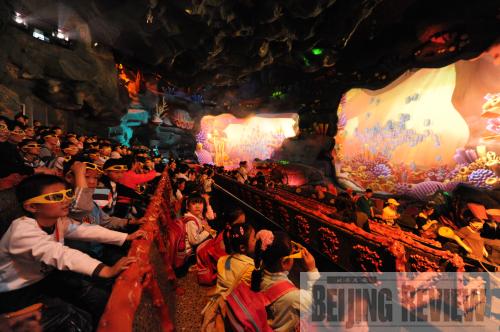|
 |
|
COMING TO LIFE: Children watch a 3-D film at the Wuhu Fangte Animation Theme Park in Anhui Province on April 28 (WANG LEI) |
When China screened its first commercial 3-D film, Journey to the Center of the Earth, a year ago, the film took in 21 million yuan ($3.07 million) with 85 percent of attendance and earned as high as 67 million yuan ($9.81 million) in 26 weeks.
More and more 3-D films are playing in China as a part of the entertainment industry that is flourishing in the country.
A new era
In July, the 3-D animated film Ice Age 3: Dawn of the Dinosaurs hit screens and took in more than 100 million yuan ($14.64 million) in 20 days. Box office receipts for the film's first five days totaling 37.5 million yuan ($5.49 million) surpassed its 2006 2-D predecessor, Ice Age 2: The Meltdown.
Another 3-D animated film in theaters now, Up, took 21 million yuan ($3.07 million) in box office earnings during its first six days.
In 2005, legendary Titanic director James Cameron predicted that 2009 would be the first big year for 3-D films. His prediction has been borne out in China, where the films have become popular.
There are about 4,000 screens on the Chinese mainland, 2,000 of which are digital. The number of 3-D screens has increased to 330, up from 80 just last year. The 3-D screens have contributed more than 300 million yuan ($43.92 million) in box-office earnings, according to the Beijing-based China Film Group Corp.
"Chinese audiences like the new 3-D technology and prefer the special experience. This is one of the main reasons for high box office returns coming from 3-D films," said Jiang Yong, a website designer who uses the three-dimensional technologies in his work.
He said the high price for 3-D film tickets is another reason for the high box office revenues of the films. "A 3-D film ticket is about 100 yuan ($14.64), much higher than the price of a normal ticket," he said.
High production and projection costs mean higher ticket prices are reasonable, said Yuan Xin, Manager of the China Film Stellar Theater Chain.
Experts said the number of Chinese 3-D screens would reach 1,300 by the end of 2010. "More than 50 percent of digital screens can be used to screen 3-D films," said Qin Hu, Vice General Manager of China Film Digital Cinema Co. Ltd.
He said a digital screen could be transformed by purchasing a set of specialized devices and 3-D glasses. The cost of the transformation runs between 200,000 and 300,000 yuan ($29,282-43,924).
Some industry insiders expressed concern about the health of the market for 3-D films. The high costs and a dearth of good film sources would hinder development, they said.
"Rich and creative content will always be the most important aspect for a good film and 3-D movies will not be an exception," said Qiu Qing, Assistant Manager of China Film South Cinema Circuit Co. Ltd.
Testing the water
While foreign 3-D films are flowing into China, Chinese filmmakers are also starting to produce their own 3-D films.
On August 16, Chinese filmmakers started shooting Nutcracker, a live-action 3-D film, in Shanghai. "We choose acrobatics as the main line of the film, trying to show audiences those demanding stunners with 3-D technology," said director Wang Guangli.
Chinese director A Gan is planning to adapt the world famous Don Quixote into a 100-minute-long 3-D film. He has brought in professional equipment and technical staff from Germany.
China's first 3-D film, China Idol Boys, began showing around the country on August 25. There are only 20 minutes of 3-D scenes in the film. The producer said the complicated production process limited the length of 3-D scenes.
"It was our first time to produce a 3-D film. We did not have any experience so we had to explore the technology as we produced the film," said director Lin Huaquan, "We are just having a try."
Filming techniques for 3-D usually involve recording two images simultaneously with two cameras positioned side by side. The cameras generally face each other and film at a 90-degree angle using mirrors in perfect synchronization and with identical technical characteristics. The effect causes each eye to see the image's counterpart and the viewer's visual cortex interprets the pair of images as a single three-dimensional picture. Modern technology also allows for the production of pseudo-3-D films using computer-generated images and without the need for two cameras.
"A big challenge for 3-D film is to look for its special language," Lin said.
The 3-D epic Finding the Milu King: The Magic Reel won in the Best Animated Film category of the 13th Huabiao Awards, China's official film awards, on August 29.
The film's producers invested 35 million yuan ($5.12 million) and invited the team that created Kung Fu Panda to produce it, making it as technically advanced as a Hollywood movie.
They also cooperated with the Chinese Academy of Sciences to use the most advanced equipment and technology to combine modern filmmaking with traditional Chinese aesthetic ideas. | 